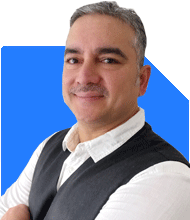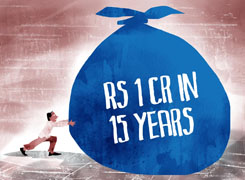21-Year-Old Aims for 1.5 Crore in 10 Years: Expert Investment Advice
Ramalingam Kalirajan |10874 Answers |Ask -Follow
Mutual Funds, Financial Planning Expert - Answered on Aug 23, 2024
He has an MBA in finance from the University of Madras and is a certified financial planner.
He is the director and chief financial planner at Holistic Investment, a Chennai-based firm that offers financial planning and wealth management advice.... more

Hello sir, I am 21 and want my bank balance to be more than 1.5 cr in next ten years,please suggest how much and where to invest?
Evaluating Your Investment Capacity
At 21, you have time on your side. The earlier you start, the better your chances of achieving this goal. Before we discuss where to invest, let’s evaluate your monthly savings potential.
Monthly Savings:
Start by calculating how much you can save every month. Ensure you’re saving as much as possible after covering your expenses.
Risk Tolerance:
Being young, you can afford to take calculated risks. This approach can yield higher returns over time.
Why Mutual Funds Are Suitable
For long-term wealth creation, mutual funds are one of the best options. They offer:
Diversification:
Mutual funds invest in a variety of assets, reducing risk.
Professional Management:
Fund managers make informed decisions, which can lead to better returns.
Flexibility:
You can start with small amounts and increase your investment over time.
Systematic Investment Plan (SIP) Approach
A Systematic Investment Plan (SIP) is a disciplined way to invest. By investing a fixed amount monthly, you can benefit from rupee cost averaging. This strategy helps reduce the impact of market volatility.
Target SIP Amount:
To achieve Rs. 1.5 crores in ten years, you’ll need to invest a significant amount regularly. Depending on the expected rate of return, you may need to invest around Rs. 25,000 to Rs. 30,000 per month.
Consistent Investing:
Stick to your SIP plan. Consistency is key. Avoid stopping your SIPs during market downturns.
Selecting the Right Mutual Funds
Given your goal, you should focus on funds that have the potential to deliver higher returns over time. Here’s what to consider:
Equity Funds:
These funds invest primarily in stocks. They offer higher returns but come with higher risk. For long-term goals, equity funds are ideal.
Hybrid Funds:
These funds invest in both equity and debt. They offer balanced risk and returns. They are good for a moderate risk approach.
Avoid Index Funds:
Actively managed funds usually outperform index funds over the long term. They offer better returns due to active management.
Lump Sum vs. SIP
If you receive a windfall or have a lump sum amount, consider investing it strategically. For long-term goals, investing through a SIP is more beneficial. However, lump sum investments can be done during market corrections.
Lump Sum Investments:
Invest during market corrections. This can help you buy more units at a lower cost.
SIP for Regular Income:
SIPs ensure regular investing, reducing the risk of market timing.
The Importance of Diversification
Diversification is essential to manage risk. Avoid putting all your money into one type of fund or sector.
Equity Diversification:
Invest in funds that focus on different sectors and market caps (large-cap, mid-cap, small-cap).
Hybrid Diversification:
Consider funds that mix equity and debt. They balance risk and returns.
Role of Debt Funds
While equity funds should be the primary focus, debt funds can provide stability. They are less volatile and offer steady returns.
Stability in Returns:
Debt funds offer lower returns but with lower risk. They are useful for parking funds you might need in the short term.
Emergency Fund:
Keep an emergency fund in debt funds. This ensures liquidity without compromising your long-term goal.
Tracking and Reviewing Your Investments
Regularly track your investments and make adjustments as needed.
Annual Reviews:
Check your portfolio once a year. Ensure it aligns with your goals.
Adjusting SIPs:
Increase your SIP amount as your income grows. This accelerates your wealth creation.
Risk Management
While aiming for Rs. 1.5 crores, it’s important to manage risk.
Avoid High-Risk Bets:
Stick to diversified mutual funds. Avoid sectoral or thematic funds unless you have a high-risk appetite.
Stay Invested:
Don’t panic during market volatility. Stay invested for the long term to reap the benefits.
Final Insights
Achieving a bank balance of Rs. 1.5 crores in ten years is possible with disciplined investing. Start by evaluating how much you can save monthly. Invest primarily in equity mutual funds through SIPs for long-term growth. Balance your portfolio with hybrid and debt funds for stability. Avoid index funds and direct funds to ensure better returns and management.
Track your investments regularly and adjust them based on your financial situation. With consistent effort and smart investment choices, you can achieve your goal.
Best Regards,
K. Ramalingam, MBA, CFP,
Chief Financial Planner,
www.holisticinvestment.in
You may like to see similar questions and answers below
Advait Arora | Answer |Ask -Follow
Financial Planner - Answered on Nov 22, 2023
Ramalingam Kalirajan |10874 Answers |Ask -Follow
Mutual Funds, Financial Planning Expert - Answered on Apr 12, 2024
Ramalingam Kalirajan |10874 Answers |Ask -Follow
Mutual Funds, Financial Planning Expert - Answered on May 20, 2024
Ramalingam Kalirajan |10874 Answers |Ask -Follow
Mutual Funds, Financial Planning Expert - Answered on Jul 02, 2024
Ramalingam Kalirajan |10874 Answers |Ask -Follow
Mutual Funds, Financial Planning Expert - Answered on Jul 18, 2024
Mayank Chandel |2569 Answers |Ask -Follow
IIT-JEE, NEET-UG, SAT, CLAT, CA, CS Exam Expert - Answered on Dec 08, 2025
Mayank Chandel |2569 Answers |Ask -Follow
IIT-JEE, NEET-UG, SAT, CLAT, CA, CS Exam Expert - Answered on Dec 08, 2025

Mayank Chandel |2569 Answers |Ask -Follow
IIT-JEE, NEET-UG, SAT, CLAT, CA, CS Exam Expert - Answered on Dec 08, 2025
Mayank Chandel |2569 Answers |Ask -Follow
IIT-JEE, NEET-UG, SAT, CLAT, CA, CS Exam Expert - Answered on Dec 08, 2025
Mayank Chandel |2569 Answers |Ask -Follow
IIT-JEE, NEET-UG, SAT, CLAT, CA, CS Exam Expert - Answered on Dec 08, 2025
Anu Krishna |1746 Answers |Ask -Follow
Relationships Expert, Mind Coach - Answered on Dec 08, 2025
Ramalingam Kalirajan |10874 Answers |Ask -Follow
Mutual Funds, Financial Planning Expert - Answered on Dec 08, 2025
Samraat Jadhav |2499 Answers |Ask -Follow
Stock Market Expert - Answered on Dec 08, 2025
Ramalingam Kalirajan |10874 Answers |Ask -Follow
Mutual Funds, Financial Planning Expert - Answered on Dec 08, 2025
Radheshyam Zanwar |6737 Answers |Ask -Follow
MHT-CET, IIT-JEE, NEET-UG Expert - Answered on Dec 08, 2025












.jpg)











